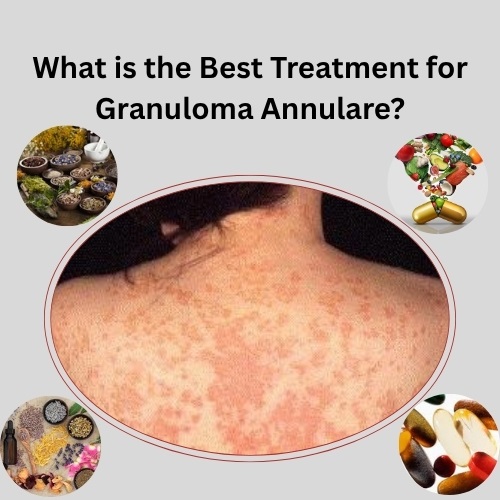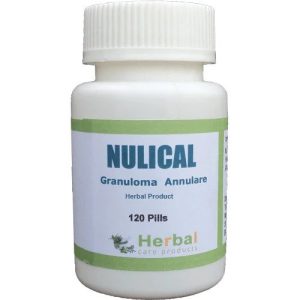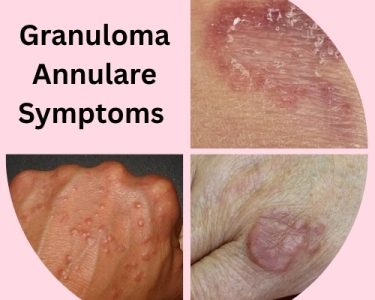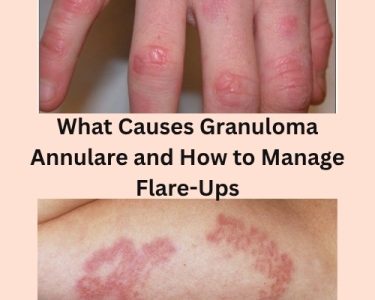Granuloma annulare can be frustrating and difficult to manage, especially when it becomes persistent or widespread. This skin condition, often appearing as raised, reddish or skin-coloured bumps arranged in ring patterns, is usually harmless but may cause concern due to its appearance. Understanding the most effective treatment for granuloma annulare can help manage symptoms and improve skin appearance.
What Causes Granuloma Annulare?
The exact cause isn’t fully understood, but granuloma annulare is thought to be linked to immune system activity. It may be triggered by skin injuries, certain medications, infections, or underlying health conditions like diabetes or thyroid disorders. In many cases, the condition clears up on its own, but persistent or widespread forms may need medical support.
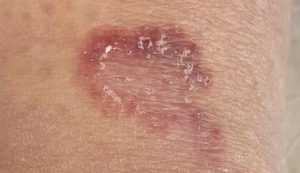
Granuloma Annulare Treatment Options
There are several options available for treating granuloma annulare. The choice depends on the severity of the condition, the areas affected, and how long it has been present.
1. Topical Corticosteroids
Topical corticosteroids are often the first choice. These anti-inflammatory creams or ointments help reduce swelling and redness. Applying them under an occlusive dressing can increase their effectiveness.
2. Intralesional Steroid Injections
For isolated patches that don’t respond to creams, steroid injections into the lesion may help flatten and reduce the size. This treatment for granuloma annulare is especially useful for lesions on visible areas like the hands or feet.
3. Phototherapy
Phototherapy, particularly narrowband UVB treatment, can help with widespread granuloma annulare. It involves exposing the affected skin to ultraviolet light under medical supervision. It’s usually offered when other methods fail to give results.
4. Oral Medications
In more severe cases, oral medications such as antimalarials (e.g. hydroxychloroquine), isotretinoin, or dapsone may be considered. These drugs can help suppress the immune response causing the lesions. However, they come with side effects and require close monitoring.
5. Natural Treatment for Granuloma Annulare
Granuloma annulare is a chronic skin condition characterized by ring-shaped lesions, usually appearing on the hands, feet, or elbows. While it is often harmless, its appearance can cause distress. Fortunately, natural treatment for granuloma annulare may offer relief without the use of harsh chemicals or steroids. Options like aloe vera, apple cider vinegar, and essential oils (such as tea tree or lavender) are commonly used for their anti-inflammatory and skin-healing properties. These natural remedies for granuloma annulare help soothe irritation, reduce inflammation, and support the skin’s natural regeneration process.
Incorporating dietary changes can also be beneficial as part of a granuloma annulare natural treatment plan. Eliminating processed foods, reducing sugar intake, and consuming anti-inflammatory foods like leafy greens, fatty fish, and turmeric may help the body heal from within. Additionally, boosting the immune system with supplements like vitamin D and omega-3 fatty acids can enhance skin health. While natural methods may not work for everyone, many individuals find them to be a safe and supportive way to manage symptoms and prevent flare-ups.
6. Homeopathic Treatment for Granuloma Annulare
Homeopathic treatment for granuloma annulare offers a gentle and natural approach to managing this chronic skin condition. By focusing on the individual’s overall health and specific symptoms, homeopathic remedies aim to stimulate the body’s self-healing abilities without harsh side effects. Commonly used remedies such as Silicea, Calcarea Carbonica, and Thuja Occidentalis may help reduce inflammation, support skin regeneration, and prevent recurrence. Many patients turn to homeopathic treatment for granuloma annulare to address the root causes rather than just suppressing symptoms, making it a preferred option for long-term relief.
How Do You Get Rid of Granuloma Annulare?
If you’re wondering how do you get rid of granuloma annulare, the answer depends on the severity and persistence of the condition. In many cases, granuloma annulare resolves on its own without treatment within a few months to a couple of years. However, for those dealing with discomfort or cosmetic concerns, various treatment options can help. These include topical corticosteroids, cryotherapy (freezing the lesions), or light therapy. Natural approaches like aloe vera gel, turmeric, and essential oils may also help soothe inflammation and promote healing.
When searching for how do you get rid of granuloma annulare effectively, it’s important to identify potential triggers like stress, infections, or underlying health conditions. Maintaining a healthy lifestyle, managing stress, and supporting your immune system can aid in preventing flare-ups. Always consult a dermatologist to determine the best treatment based on your specific case, especially if the condition becomes chronic or spreads.
Related Articales: How Can I Stop Granuloma Annulare from Spreading
New Treatments for Granuloma Annulare
Research into new treatments for granuloma annulare continues, particularly for generalised or resistant cases. Some promising options include:
- Biologics: Medications like adalimumab (used for autoimmune conditions) are being studied as a new treatment for granuloma annulare due to their immune-modulating effects.
- Janus Kinase (JAK) Inhibitors: These target specific pathways in the immune system and may offer relief for stubborn forms of the condition.
- Laser Therapy: Some dermatologists now use laser therapy to reduce the appearance of lesions, especially where pigment changes are noticeable.
If you’re searching for granuloma annulare treatments that go beyond the traditional, it’s worth discussing these newer options with a dermatologist. Many people ask what is the best treatment for granuloma annulare, and while the answer varies by individual, staying informed about new treatments for granuloma annulare helps you make better choices.
Natural and Supportive Measures
Although not proven cures, supportive strategies can complement medical treatments:
- Avoid known triggers like certain medications or prolonged sun exposure.
- Keep the skin moisturised to reduce dryness and itching.
- Manage underlying conditions, such as diabetes or thyroid issues, that might contribute.
Some people also explore dietary changes or Herbal Supplement for Granuloma Annulare, although evidence for these approaches remains limited.
Related Articales: Top 10 Best Vitamins Granuloma Annulare :Boost Your Skin Health
Annulare granuloma (also called granuloma annulare) is a benign skin condition often seen in children. It presents as small, firm bumps that form ring-shaped or annular patterns, usually on the hands, feet, elbows, or knees. While the exact cause is unknown, it’s believed to be linked to minor skin trauma, insect bites, or immune responses. It’s not contagious and usually doesn’t cause pain or itching.
Types of Annulare Granuloma
- Localized– Most common in children; affects a small area.
- Generalized– Rare in kids; affects multiple parts of the body.
- Subcutaneous– Found as deep lumps under the skin, especially in younger children.
- Perforating– Rare; involves lesions that expel material from the skin.
Is Treatment Always Necessary?
In many cases, no treatment is needed. The condition is self-limiting and often clears up on its own within a few months to a couple of years. However, if lesions are widespread, persistent, or bothersome cosmetically, treatment may be considered.
Related Articales: Granuloma Annulare Rash:The Condition and Treatment Option
Treatment Options for Children
1. Observation and Reassurance
- Best first step for localized or mild cases.
- Pediatric dermatologists often recommend watchful waiting.
- Emphasize to the child and family that it’s not harmful or contagious.
2. Topical Steroids
- Mild to moderate potency creams (e.g., hydrocortisone, triamcinolone).
- Applied directly to the lesion once or twice daily for a few weeks.
- Helps reduce inflammation and speed up resolution.
3. Intralesional Steroid Injections
- For larger or persistent lesions.
- A small amount of corticosteroid is injected into the lesion.
- Typically avoided in very young children unless absolutely necessary.
4. Cryotherapy (Freezing)
- Involves applying liquid nitrogen to the lesion.
- Not commonly used in children due to discomfort and potential for scarring.
5. Light Therapy (Phototherapy)
- UV light treatments may help with generalized or resistant cases.
- Used under medical supervision, typically in a dermatology clinic.
6. Systemic Treatments (Rarely Used in Children)
- In severe, widespread cases, oral medications like dapsone or isotretinoin might be considered—but only under strict medical supervision.
- Usually reserved for adults due to potential side effects.
Home Remedies for Granuloma Annulare
Home remedies for granuloma annulare offer a natural approach to managing this chronic skin condition, which is often characterized by ring-shaped lesions on the skin. While the exact cause of granuloma annulare is still unknown, many people find relief through gentle, at-home treatments. Applying aloe vera gel, known for its anti-inflammatory and soothing properties, can help reduce irritation and redness. Additionally, using coconut oil or vitamin E oil may improve skin healing and keep the affected areas moisturized, which can minimize discomfort and promote recovery over time.
Granuloma annulare home remedies also include lifestyle adjustments that support overall skin health. A balanced diet rich in antioxidants, such as leafy greens and berries, may help boost the immune system and reduce flare-ups. Some individuals have reported improvements by avoiding triggers like stress, allergens, or certain skincare products. Although these home remedies for granuloma annulare may not provide an instant cure, they can significantly ease symptoms and improve the skin’s appearance when used consistently.
Choosing the Right Approach
The best treatment for granuloma annulare often depends on how the condition presents. For localised lesions, a simple topical steroid may be enough. For more persistent or widespread forms, systemic treatments or new treatments for granuloma annulare may offer better results. If you’re exploring treatments for granuloma annulare, or considering a treatment granuloma annulare approach that includes newer medical therapies, speak with a qualified dermatologist. In some cases, a combination of treatments may be the most effective.
For more information on holistic approaches and how they complement conventional care, read our article on granuloma annulare treatment strategies that combine medical insight with lifestyle support.

